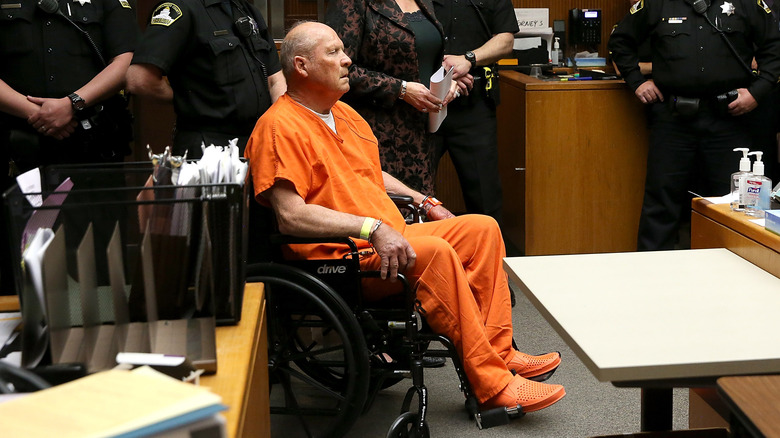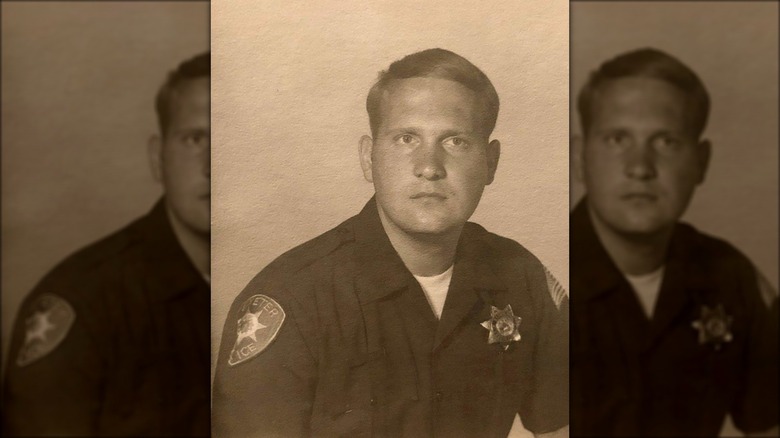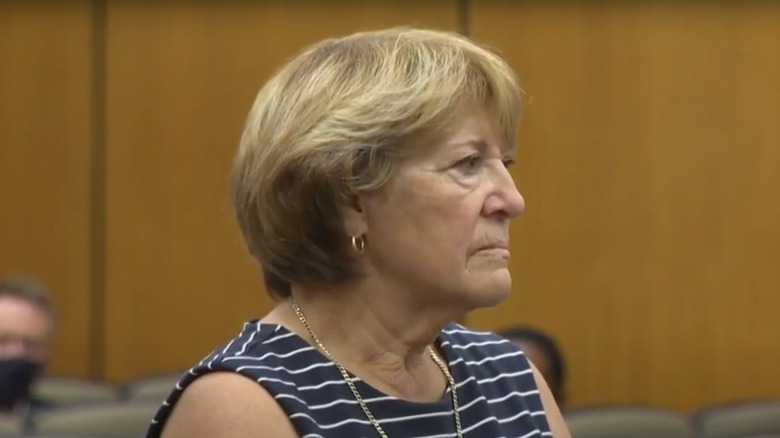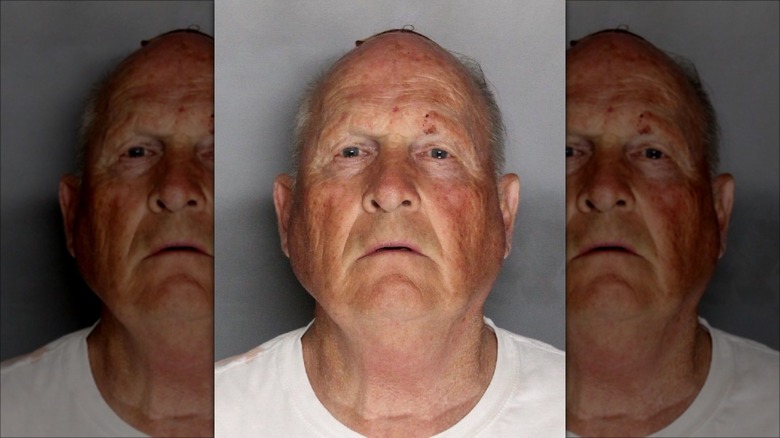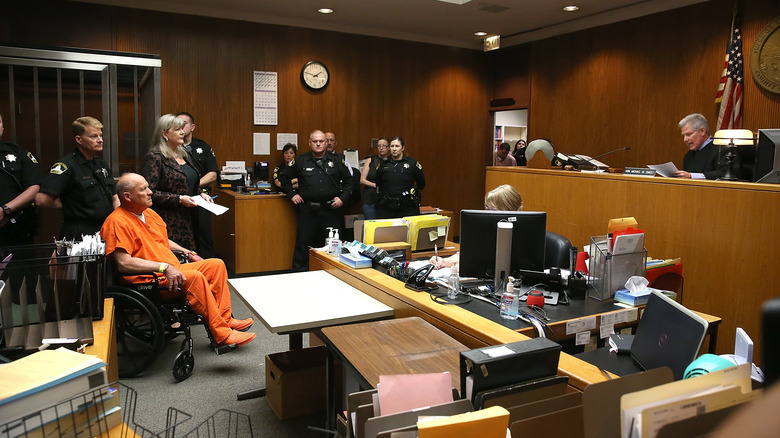The Most Disturbing Details About The Golden State Killer
In 2018, the lingering cold case of the Golden State Killer was finally on its way to being solved. That year, 72-year-old Joseph DeAngelo was arrested at his home in Citrus Heights, California. In 2020, he pled guilty to 13 counts of murder and over 50 rapes committed during the 1970s and 1980s, receiving a life sentence without the possibility of parole. Though the statute of limitations meant some offenses were too old to prosecute, DeAngelo ultimately admitted to 161 total crimes.
Now, we can be all but certain that DeAngelo wasn't just the Golden State Killer, but also likely the Cordova Cat Burglar, who stalked the small California town of Rancho Cordova in the 1970s, and the Visalia Ransacker from 1973 to 1975. This is suspected to be when he committed his first sexual assaults and murders, before moving back to the Sacramento area and committing similar attacks identified as the East Area Rapist and the Original Night Stalker (later renamed the Golden State Killer by writer Michelle McNamara in 2013).
As the East Area Rapist from July 1976 to July 1979, he established a pattern of entering homes, restraining young women and girls, and sexually assaulting them. By 1977, as those living in and around Sacramento began to fear the unidentified criminal, DeAngelo began to strike couples and families, finally stopping around 1986. It took decades for DNA evidence to link him to his crimes and give us a fuller, but deeply disturbing picture of the Golden State Killer.
Joseph DeAngelo had an unstable childhood
Though it's not a given for all, one trait Joseph DeAngelo has in common with quite a few other serial killers is a difficult childhood (though plenty of people have troubled upbringings and go on to murder no one at all). His father's career as an officer in the U.S. Air Force meant that the family regularly moved. Eventually, they landed in Rancho Cordova, California. When DeAngelo's father was reassigned to Korea, the rest of the family — including DeAngelo's mother and three siblings — remained in Rancho Cordova. Perhaps it was for good reason: At DeAngelo's 2020 sentencing for 13 counts of first-degree murder, a statement written by his sister and read in the Sacramento County Courthouse alleged that their father was abusive and a philanderer. While DeAngelo was still a minor, his mother worked and began seeing another man. The young DeAngelo was expected to take on the bulk of care for his younger siblings.
Eventually, DeAngelo began to grow close with a friend's family, to the point where he referred to the parents as his own mother and father — and they began to see him as their own child, too. He even imitated the actions of his best friend and the family's oldest son, to the point of enlisting in the U.S. Navy. After three years of service and an honorable discharge, he returned to California and began living with his birth mother again, where he enrolled in college.
He worked as a police officer
After attending Cal State Sacramento, Joseph DeAngelo proceeded to graduate from police academy and interned with the Roseville, California, police department. He joined the tiny, 10-person police department of Exeter, California, in the mid-1970s. At the same time, the small town of Visalia was being menaced by a stalker who entered homes and occasionally stole small items, but seemed more interested in ransacking lingerie drawers and violating residents' sense of security.
The Visalia Ransacker, as he was known, committed an estimated 120 burglaries only 10 minutes from Exeter. It wasn't unlike the string of crimes committed by another unidentified figure a few years earlier, who was known as the Cordova Cat Burglar and operated in an area familiar to DeAngelo.
During this time, DeAngelo continued in his law enforcement career, earning a promotion to investigator. After committing more home break-ins and a series of sexual assaults in the area — perhaps covered up when DeAngelo was one of the responding officers, as one former colleague told 60 Minutes Australia — he joined the Auburn police department near Sacramento. His hiring officer was unimpressed, noting DeAngelo would turn sullen when criticized, was overly tough, and never distinguished himself. In July 1979, when he was caught shoplifting, that same officer — who had become the department's chief — fired DeAngelo. The same officer later suspected that a vengeful DeAngelo stalked his daughter, but never attempted to investigate and potentially let the killer go free for many more years.
He surveilled victims before attacking
Joseph DeAngelo seemingly exploited his knowledge of police investigation to elude capture, using his familiarity with response times and crime scene techniques to more efficiently escape. While in homes as the Visalia Ransacker, he reportedly placed perfume bottles on doorknobs to alert him of any entries and left windows and doors open to facilitate quick escapes. Other investigators noted that, in later crimes, he must have carefully observed the comings and goings of a home's residents, going so far as to cut phone lines and turn off appliances so he could more effectively hear everything. The 2018 arrest affidavit for DeAngelo suggested that he targeted homes that backed onto drainage ditches or river bottoms, allowing him a convenient spot to hide while casing a home and its inhabitants.
As the East Area Rapist, he often lingered in homes for hours, having carefully constructed the schedules not just of his victims, but of neighbors who might have noticed something was off if they were in the area. He had even entered some homes prior to the attacks, going so far as to stash supplies he would need to restrain victims and taking the bullets out of guns he found inside the home. He's even suspected of planting evidence in an attempt to fool investigators into thinking the perpetrator was a neighbor or someone from out of town.
The killing began in 1975
Joseph DeAngelo's first known murder took place on September 11, 1975. That evening, he attempted to abduct Elizabeth Snelling, the daughter of professor Claude Snelling, from their Visalia home. The 16-year-old Elizabeth had already been the target of a strange man peeking into her window twice before. Finally, the man entered the home, woke Elizabeth, and pulled her outside while pointing a gun at her. When her father pursued, the man fired and struck Claude, killing him. Later that year, a Visalia burglar was nearly apprehended by a police officer, but the man fired at the officer (who narrowly escaped being hit) and ran away.
The next known killings appear to have been the deaths of Brian and Katie Maggiore, a young married couple who were walking their dog in Rancho Cordova on the evening of February 2, 1978. A witness saw them fleeing through neighborhood backyards from an assailant, who fired at them. Both were shortly found nearby, dead or dying of gunshot wounds. Though no DNA was recovered from the scene, circumstantial evidence (including a uniquely knotted shoelace found at the scene) suggests it was DeAngelo, perhaps interrupted in the midst of a home invasion.
In December 1979, Dr. Debra Manning and Dr. Robert Offerman were found dead in Offerman's condo, the crime scene sporting the hallmarks of the same killer. Just a few months later, in March 1980, Lyman and Charlene Smith were found in their home, also seemingly killed by the same individual.
Victims' family members were also targeted
Joseph DeAngelo did not just target individual victims, as was made all too clear by his increasing number of murders and assaults through the 1970s and into the 1980s, which began to include couples and entire families. His crimes were also increasingly inspiring fear in whole neighborhoods and regions of California as word got out that a criminal was targeting women and their families.
Even before the known killings occurred, family dogs seem to have been a target of DeAngelo, who perhaps did not want a barking canine alerting homeowners and neighbors to his presence. But it wasn't a simple matter of eliminating an alarm. The intruder brutally dispatched some animals with a bludgeon and went to even greater effort in order to traumatize families, as some dogs were reportedly shot and then placed inside their family's home to die and be discovered in shocking fashion.
As the crimes escalated, DeAngelo was known to tie up the spouses of women he was assaulting, demanding that they remain still. If they moved — DeAngelo reportedly balanced perfume bottles or plates on their backs as an ersatz alarm system — he threatened to bring them pieces of their wife's body or to kill them. Children were also sometimes restrained in homes while assaults occurred, either tied up like other adults or locked inside bathrooms.
He lingered in victims' homes
Survivors of Joseph DeAngelo have noted that his attacks could take an agonizing amount of time, as he lingered in their homes for hours. He repeatedly assaulted women during this time, sometimes going to their partners to threaten them for moving or dislodging the plates or other nearby pieces of household ephemera he had stacked on their backs. DeAngelo would reportedly take breaks to rifle through the home, sometimes eating food and drinking beer from the kitchen.
Sometimes, the attacker would return to stand above his victims, taunting them with further harm, naming their relatives, or simply looming near them while breathing loudly. Others noted that the East Area Rapist would sometimes begin crying in the midst of an attack. However, it's unclear if this was a genuine emotional reaction — sometimes, the attacker would apparently retreat to a different part of the home for a crying session — or if DeAngelo was attempting to play off the assumption (as sometimes championed by news media at the time) that the attacker was mentally unstable.
He continued to traumatize victims after assaults
Those who survived Joseph DeAngelo's attacks were often left with lasting trauma from their experiences that haunted them for decades, as victim impact statements from DeAngelo's 2020 sentencing dramatically illustrated. But, even after he left their homes, DeAngelo was seemingly not content to leave victims to their trauma. Instead, the evidence indicates that he would call them, sometimes many weeks after the attacks, threatening further harm in a chilling whisper. Other survivors said that they suspected frequent calls that featured only silence followed by an abrupt hang-up were also the work of their attacker.
Reports also indicate that DeAngelo sometimes was so bold as to physically return to places frequented by his victims in order to further torment them. One man said he arrived at his construction job to find his seat held the same restraints used during the attack on him and his wife. And a portion of the couples targeted by DeAngelo simply crumbled under the weight of their combined trauma, with a significant number — some say more than half – divorcing or separating in the years following their attacks.
One innocent woman took some of the blame
Once, Bonnie Colwell was a college student, as well as the girlfriend and, briefly, fiancée of a young Joseph DeAngelo. Then, she began to experience an increasing pattern of controlling, dangerous behavior from DeAngelo. As she later told investigators, sexual encounters with DeAngelo were hours-long and painful, a factor he either didn't notice or didn't care about. In daily life, she wasn't treated as if she could give consent, either. "[T]here was never the option to choose. I was already committed," she told the Los Angeles Times. "I just sort of had to throw my trust with him in many situations where I was initially uncomfortable with the choices he made." Colwell dumped him in 1971. During a 1978 attack, he broke down in tears and angrily mentioned her name. When DeAngelo was apprehended, some media outlets blamed Colwell for kicking off his series of murders.
It's hardly fair to expect all women with terrible boyfriends to stay with them, even on the off chance he's a budding serial killer. Neither is it guaranteed that Colwell marrying DeAngelo would have done much of anything, besides putting her in danger. Multiple serial killers have held down family life, as BTK's children could tell you. DeAngelo himself got married to lawyer Sharon Huddle in 1973, going on to have three daughters. Huddle divorced him in 2019 (though they'd been separated for years prior to his 2018 arrest).
It took decades to arrest him
From his first known crimes to his 2018 arrest, Joseph DeAngelo spent over 40 years free. Yet, the evidence was there, from common patterns of behavior, consistent territories, and DNA evidence. So, why was he unheard-of before 2018?
For one, DeAngelo used his police training to avoid leaving evidence. He routinely wore gloves and a mask, meaning police couldn't find fingerprints or get a good physical description from victims. Moreover, the killings seem to have stopped in 1986, when news of the first murder case solved by DNA evidence came to light. Perhaps DeAngelo, wary of new investigative techniques, was finally pressured to step back from his decades-long criminal career.
Then, there was the issue of inconsistent communication between law enforcement agencies, which made it all the more difficult to connect the dots. It wasn't until retired police investigator Paul Holes turned to genetic databases that the picture became more clear. Using a DNA sample taken from the 1980 murder scene in Charlene and Lyman Smith's home, Holes and his associates found distant relatives of the assailant in the GEDmatch database, using a process now widely known as "genetic genealogy." Using careful genealogical research, investigators were finally able to track DeAngelo down through these relations. After tailing him and surreptitiously collecting DNA samples from a tissue and car door, they were able to confirm that he was a match for the crime scene material and the Golden State Killer was finally arrested.
DeAngelo's courtroom behavior chilled some
Though he was part of the small group of serial killers who took decades to be caught, Joseph DeAngelo was finally arrested in 2018. But, once in the courtroom, DeAngelo's behavior struck some as odd. Oftentimes taken into the room in a wheelchair, he appeared to many to be a frail old man. Was this a ploy by his defense team to paint the picture of a harmless member of society who presented no threat? Maybe, or at least that's what some of his victims believed when they attended his 2020 court proceedings. After his sentencing, surveillance footage released by the Sacramento County District Attorney showed part of DeAngelo's life in prison, moving around in his cell without need for a wheelchair and appearing fairly physically capable as he did light exercise and even climbed atop a desk, as District Attorney Anne Marie Schubert noted when discussing the video (via KCRA 3).
Back in court, having been sentenced to life in prison, DeAngelo addressed onlookers. "I've listened to all your statements," he said. "Each one of them. And I'm truly sorry to everyone I have hurt. Thank you, your honor" (via ABC News). But for many, including victims in attendance, this brief apology was hardly enough to make up for the decades of lasting trauma.
His arrest raised serious questions about genetic privacy
The use of genetic genealogy to arrest the Golden State Killer has been hailed as a breakthrough that represents a new way to solve lingering cold cases. Estimates vary, but to date, hundreds of cases have now been closed thanks to this advancement.
But while it may seem like the holy grail of forensic investigations, genetic genealogy and how it was used in the case of the Golden State Killer has a potential dark side. Consider that suspects like Joseph DeAngelo didn't directly contribute their DNA to a database. Instead, distant cousins did, but nevertheless law enforcement was able to track him down. While you may or may not have sympathy for the privacy of the Golden State Killer, it's not much of a mental leap to wonder if unfettered use of this technology could lead to overly intense surveillance, perhaps even of innocent citizens.
Law enforcement's specific use of the GEDmatch database to catch DeAngelo is also ethically murky. Yes, people voluntarily uploaded their genetic profiles to the database, but GEDmatch wasn't created to help with criminal investigations. The database founders concluded that law enforcement didn't strictly violate the terms of use when it uploaded DeAngelo's crime scene DNA or tracked down his relatives. Many others claim that the potential violation of privacy is worth it if it also apprehends criminals, so long as there are robust protections in place (though what, exactly, those protections should be is still in flux).
If you or anyone you know has been a victim of sexual assault or is dealing with domestic abuse, contact the relevant resources below:
- Visit the Rape, Abuse & Incest National Network website or contact RAINN's National Helpline at 1-800-656-HOPE (4673).
- Call the National Domestic Violence Hotline at 1−800−799−7233. You can also find more information, resources, and support at their website.
